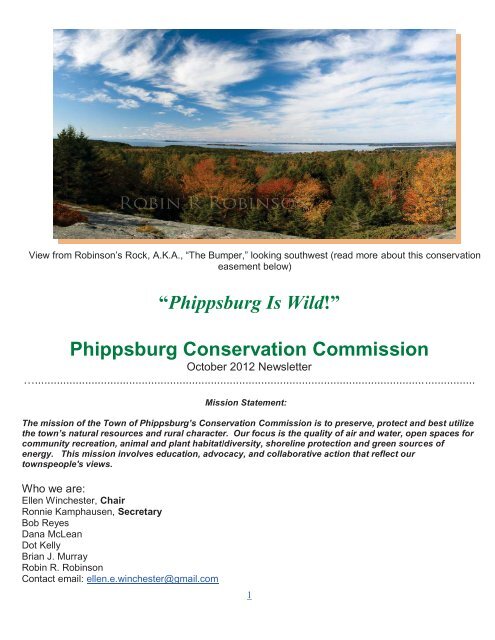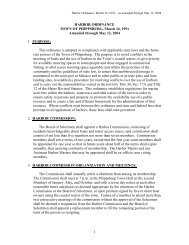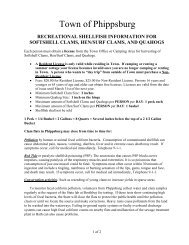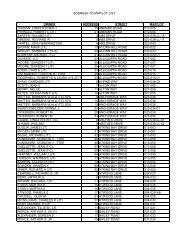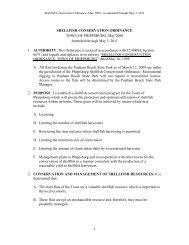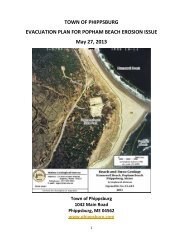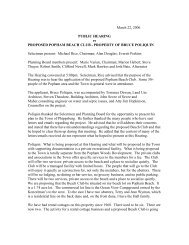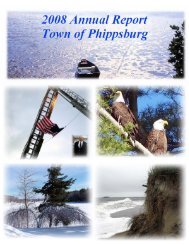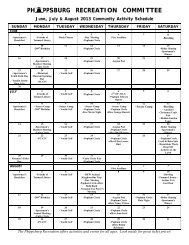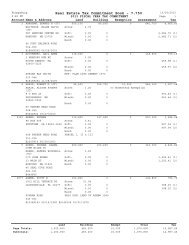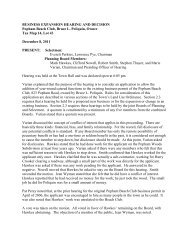October 2012 Newsletter - Town of Phippsburg
October 2012 Newsletter - Town of Phippsburg
October 2012 Newsletter - Town of Phippsburg
You also want an ePaper? Increase the reach of your titles
YUMPU automatically turns print PDFs into web optimized ePapers that Google loves.
View from Robinson’s Rock, A.K.A., “The Bumper,” looking southwest (read more about this conservation<br />
easement below)<br />
“<strong>Phippsburg</strong> Is Wild!”<br />
<strong>Phippsburg</strong> Conservation Commission<br />
<strong>October</strong> <strong>2012</strong> <strong>Newsletter</strong><br />
…............................................................................................................................................<br />
Mission Statement:<br />
The mission <strong>of</strong> the <strong>Town</strong> <strong>of</strong> <strong>Phippsburg</strong>’s Conservation Commission is to preserve, protect and best utilize<br />
the town’s natural resources and rural character. Our focus is the quality <strong>of</strong> air and water, open spaces for<br />
community recreation, animal and plant habitat/diversity, shoreline protection and green sources <strong>of</strong><br />
energy. This mission involves education, advocacy, and collaborative action that reflect our<br />
townspeople's views.<br />
Who we are:<br />
Ellen Winchester, Chair<br />
Ronnie Kamphausen, Secretary<br />
Bob Reyes<br />
Dana McLean<br />
Dot Kelly<br />
Brian J. Murray<br />
Robin R. Robinson<br />
Contact email: ellen.e.winchester@gmail.com<br />
1
To find out more about the role <strong>of</strong> our conservation commission, visit the Maine<br />
Association <strong>of</strong> Conservation Commissions web site here.<br />
Conservation Commission - report to town <strong>of</strong> <strong>Phippsburg</strong> for the year 2011<br />
<strong>Phippsburg</strong> Conservation Commission Survey UPDATE<br />
If you have not already filled out our survey PLEASE take a few minutes to fill it out here:<br />
<strong>Phippsburg</strong> Conservation Commission TOWN SURVEY<br />
The following two respondents to the first incarnation <strong>of</strong> our survey<br />
WON AN OFFICIAL “<strong>Phippsburg</strong> is WILD!” BASEBALL CAP ! ! ! ! !<br />
Barbara M. Clark<br />
Dan and Katherine HINCKLEY<br />
To ARRANGE DELIVERY <strong>of</strong> your cap, please contact us here:<br />
ellen.e.winchester@gmail.com<br />
If anyone is interested in purchasing a baseball cap for $20, please contact us here:<br />
Bob Reyes <br />
For current projects and the minutes <strong>of</strong> The <strong>Phippsburg</strong> Conservation Commission<br />
meetings, click HERE.<br />
See our terrific bulletin board with great photos and information at the<br />
<strong>Phippsburg</strong> <strong>Town</strong> Hall!<br />
2
WHAT’S A CONSERVATION EASEMENT?”<br />
Robinson’s Rock, also known as “The Bumper,” shown in the <strong>October</strong> newsletter banner<br />
photograph, is private land to which public access has been granted. It is a conservation<br />
easement.<br />
What is a conservation easement? We’re glad you asked! A conservation easement (also<br />
known as a covenant or conservation restriction), is a legally enforceable land preservation<br />
agreement between a landowner and our town. Sometimes these preservation<br />
agreements are made with landowners and land protection organizations, such as The<br />
<strong>Phippsburg</strong> Land Trust or The Nature Conservancy.<br />
For the purpose <strong>of</strong> land conservation, easements restrict real estate, commercial and<br />
industrial development. Once an easement is in place, it “runs with the land.” That is, even<br />
after a property is sold, the terms <strong>of</strong> the easement stay in effect though ownership has<br />
been transferred. Because easements are perpetual, they can decrease the resale value<br />
<strong>of</strong> the property.<br />
Landowners enter into easement agreements voluntarily and an easement may be<br />
either sold or donated. Public access to the land is <strong>of</strong>ten part <strong>of</strong> the easement agreement.<br />
Though there may be significant state and federal tax advantages, landowners are<br />
contributing to the public good by preserving conservation values associated with their<br />
land for future generations.<br />
<strong>Phippsburg</strong> has about 800 acres <strong>of</strong> land with conservation easements! We are very<br />
fortunate to have public access to these private lands. Parking, privacy and protection <strong>of</strong><br />
3
the land should be respected by everyone who uses it. When you visit a conservation<br />
easement area, please keep the noise down and take the trash out.<br />
Robinson’s Rock, as one <strong>of</strong> the higher elevations in <strong>Phippsburg</strong>, was historically a military<br />
lookout for spotting ships coming into Casco Bay from the east and the west. During the<br />
War <strong>of</strong> 1812, Colonel Robinson signaled with a warning light to Munjoy Hill fourteen miles<br />
west in Portland! On a clear day, Mount Washington can be seen and the Portland skyline<br />
across Casco Bay. It is a great place to watch migrating hawks, witness stunning sunsets<br />
and enjoy magnificent fall foliage. The wooded trail is lined with rich mosses and ferns and<br />
the spruce wood habitat is classic for grouse and porcupines. Woodcocks have been<br />
spotted near the West Point Road trail head.<br />
Map to Robinson's Rock from the West Point Road and Sebasco Road click here and<br />
access Google maps with directions. We've drawn a trail map for you!<br />
The short trail to The Bumper: From Route 209, take the Sebasco Road about ½ mile to<br />
the West Point Road. On the West Point Road, about ¼ mile on the right, is a small area<br />
to park at the trail head across the road from the Totman Preserve sign. The trail leads<br />
west up the hill. On the east end <strong>of</strong> the trail, it can be muddy. Wear good shoes. The walk<br />
takes about 10 minutes. The trail can also be accessed by way <strong>of</strong> the Sebasco Road.<br />
From Rt 209, about ½ mile - Parking is on the right side <strong>of</strong> the road. The trail head is on<br />
the left. Don't forget your binoculars!<br />
For directions to other conservation easement lands and great walking trails ,birds, flowers<br />
and other natural wonders, click HERE on the <strong>Phippsburg</strong> Land Trust web site.<br />
The <strong>Phippsburg</strong> Conservation Commission<br />
welcomes your input and ideas. If you have<br />
suggestions or photographs that you would<br />
like to see in this newsletter, please contact<br />
the editor, Robin R Robinson at 389-1609 or<br />
rrrobinson@hotmail.com<br />
4
BUNDLES OF BUTTERFLIES!<br />
Mourning Cloak butterfly photographed in Small Point, September <strong>2012</strong>. Gorgeous<br />
photograph courtesy <strong>of</strong> Dan Hinckley. Mourning Cloaks over-winter as butterflies in<br />
<strong>Phippsburg</strong>. Most butterflies overwinter as pupa or cocoons.<br />
You’re not seeing things - or maybe you are! The Monarchs are migrating and plentiful,<br />
as are the White and Red Admirals, Mourning Cloaks, Painted and American Ladies and<br />
many more. There have been much higher than usual numbers <strong>of</strong> butterflies reported in<br />
the eastern half <strong>of</strong> the United States this year. And, species that are rare in the northeast<br />
have been reported! Reasons for this remain unclear, but climate change is a suspected<br />
cause.<br />
There are approximately 20,000 species <strong>of</strong> butterflies in the world. About 725 species<br />
have occurred in North America, with about 575 <strong>of</strong> these occurring regularly in the lower<br />
48 states <strong>of</strong> the United States. Maine’s Butterfly Survey lists about 120 species.<br />
Which butterfly species and how many are seen in a geographic area is information<br />
gathered by ordinary people, such as you! The Maine Butterfly Survey is a statewide,<br />
volunteer survey effort that tracks butterflies. Consider joining the project as a citizen<br />
scientist. The butterflies you count count!<br />
5
Did you know that butterflies are playing a role in solar energy development? To stay<br />
warm, butterflies are sophisticated collectors <strong>of</strong> solar energy. Scientists believe that the<br />
shingle-like scales that form butterflies’ wings could provide important clues for developing<br />
solar technology.<br />
For more on climate change and the northerly movement <strong>of</strong> butterfly species read this:<br />
http://www.naba.org/chapters/nabambc/downloads/BreedStichterCrone<strong>2012</strong>.pdf<br />
To become a Maine butterfly science citizen click here: Maine Butterfly Survey<br />
Links for identification and information about butterflies:<br />
North American Butterfly Association<br />
Butterflies And Moths Of North America<br />
About Monarch butterflies<br />
TO SEE A GALLERY OF BUTTERFLIES PHOTOGRAPHED IN PHIPPSBURG, CLICK<br />
HERE<br />
Luna moth close up, Photographed in West Point. Look for these in late June and early July<br />
WHAT'S THAT BUG? is an excellent “web site” (oh! Bad pun, indeed!) for identifying<br />
insects and spiders. It’s a great educational site for kids.<br />
6
The photograph on the left is a Woolly Bear caterpillar. The photo on the right is a<br />
Polyphemus caterpillar. They are the caterpillar phase <strong>of</strong> the Isabella Tiger moth and<br />
the Polyphemus silk moth, respectively.<br />
Woolly Bear caterpillars are frequently seen at this time <strong>of</strong> the year. They are a<br />
caterpillar that over winters rather than turning into a cocoon or moth. They are<br />
scampering and lumbering around right now because they are looking for places to curl up<br />
for the winter rather than spending their time eating. When disturbed, Woolly Bears curl<br />
into a tight knot like a Cheese Curl. They are also one <strong>of</strong> the only caterpillars that will run<br />
away! Folk lore says that the width <strong>of</strong> the Woolly Bear’s colored, middle band is a predictor<br />
<strong>of</strong> how long the winter will be. Scientists believe that the band width is an indicator <strong>of</strong> how<br />
old the caterpillar is and how much it has eaten; not how bad or long the upcoming winter<br />
will be. The one in the above photo is pretty advanced in age and has eaten a lot.<br />
The green caterpillar above is that <strong>of</strong> the Polyphemus moth. It is one <strong>of</strong> the largest silk<br />
moths in Maine (Cecropia, Promethea and Luna are the others). These caterpillars are<br />
also looking for places to overwinter. They curl up in dried leaves and make a cocoon<br />
rather than stay like a caterpillar as the Woolly Bear does.<br />
If you are interested in keeping a Woolly Bear caterpillar for the winter so you can see the<br />
Isabella Tiger moth appear in the spring, visit this site:<br />
Care <strong>of</strong> the Woolly Bear caterpillar -<br />
Want to know about an insect you found in<br />
<strong>Phippsburg</strong>? Visit the Maine Entomological Society web site.<br />
…................................................................................<br />
7
B<br />
ittersweet makes fabulous,<br />
orange berries with yellow husks.<br />
It’s tempting to plant this for its<br />
stunning fall display. Many people use<br />
the berries in fall decorations, such as<br />
wreaths for their doors. When they do,<br />
the berries drop <strong>of</strong>f, and then sprout<br />
new growth the following spring.<br />
Bittersweet is incredibly aggressive and<br />
is on the invasive plant species list.<br />
Please don’t propagate Bittersweet<br />
either intentionally or by accident with<br />
your fall decorations. The vines climb<br />
everywhere - up, down forward and<br />
backward. The twining vines choke out<br />
what they are growing on by strangling<br />
and suffocation. Nice, huh? Keep this<br />
plant out <strong>of</strong> The Burg! It’s a monster.<br />
Bittersweet is crowding out native plant<br />
species. Pileated Woodpeckers will eat<br />
the berries, but most birds don’t eat it unless they are really desperate for food. It’s<br />
last on their preferred foods list.<br />
For info on invasive plant species in <strong>Phippsburg</strong>, see this link: Invasive Species in<br />
<strong>Phippsburg</strong> by Jo Schuman<br />
For more on other invasive plant species in Maine, look here:<br />
http://extension.umaine.edu/publications/2536e/<br />
The University <strong>of</strong> Maine has a great site with a video on How To Get Rid Of Invasive<br />
Plant Species. Click on this link for the video.<br />
One <strong>of</strong> the reasons for a conservation commission is to track and record species.<br />
This is one way that scientists know what flora and fauna live where. We need YOU<br />
to contribute and tell us what you see. This is YOUR citizen science data. This<br />
column will be devoted to reports <strong>of</strong> nature sightings in <strong>Phippsburg</strong>. The column will<br />
include wildflowers (including mushrooms), trees, birds, insects amphibians, marine<br />
and land mammals. Please let us know what you see, where and when you see it!<br />
The creature doesn’t have to be rare. We would love to include your photograph <strong>of</strong><br />
the subject, too. We will give you credit for your image. General locations will be<br />
noted, but not specific addresses, so as to preserve reporters' privacy and<br />
conservation <strong>of</strong> the species. To notify the Conservation Commission <strong>of</strong> an interesting<br />
8
nature sighting, contact Robin R Robinson at rrrobinson2010@hotmail.com or 389-<br />
1609.<br />
Let’s start here:<br />
BIRDS:<br />
Northern Goshawk- Fiddler’s Reach<br />
Road - reporter states that the<br />
Goshawk has been in residence for<br />
several years and remains current.<br />
The reporter states that previously<br />
seen grouse have been seen less<br />
<strong>of</strong>ten since the appearance <strong>of</strong> the<br />
Goshawk. Goshawks aren't rare, but<br />
are uncommon. Goshawks occupy<br />
large territories, so not many are seen<br />
in any given area. Hermit Island and<br />
Sprague River marsh are good places<br />
to see them, too.<br />
White-Winged Crossbills- Hidden<br />
Ledges Road (Small Point) - May 23,<br />
<strong>2012</strong> flock <strong>of</strong> # 16. Not rare, but<br />
uncommonly seen this far south.<br />
Normally, a bird <strong>of</strong> the northern forest.<br />
When seen here, usually in the winter,<br />
not the summer. This is a "Canadian<br />
Zone" bird.<br />
Red Crossbills- Saint John Road<br />
(Small Point) May 20, <strong>2012</strong> a small<br />
flock. Not rare, but uncommonly seen<br />
this far south - normally a bird <strong>of</strong> the<br />
northern forest, like the White Winged<br />
Crossbill.<br />
White Faced Ibis- Sam Day Hill Rd<br />
east end - June. Glossy Ibis are<br />
commonly seen in <strong>Phippsburg</strong>, but to<br />
date, only one White Faced Ibis has<br />
ever been recorded here. They<br />
normally do not come this far north or<br />
east.<br />
White Faced ibis- Sam Day Hill Rd<br />
Glossy Ibis – Sebasco Harbor<br />
9
AMPHIBIANS/REPTILES:<br />
SPOTTED TURTLE- Route 209 near<br />
Pride Rock Road and Sprague Pond<br />
Preserve (Ashdale)- June 10, 2011.<br />
turtle was crossing the road. Status:<br />
endangered<br />
Spotted Turtle, June 10, 2011<br />
MAMMALS:<br />
COYOTES – numerous reports have<br />
been made <strong>of</strong> coyotes on various<br />
roads around Small Point and along<br />
Route 209. Sightings have been<br />
made mostly around dawn.<br />
GRAY FOX- have been seen on<br />
Fiddler’s Reach Road, Heron Cove<br />
Road (Winnegance), Periwinkle Lane<br />
(West Point), Newberry Point Road<br />
(West Point) - a breeding pair with<br />
kits! Though not rare, Gray foxes<br />
were previously only a southern<br />
United States mammal that has<br />
inched its range northward.<br />
MOOSE- moose have been reported<br />
on Periwinkle Lane (West Point), Sam<br />
Day Hill Road - east end, Popham<br />
Road near Sprague River marsh<br />
WHITE-TAILED DEER- A twelve<br />
point buck was reported in the last<br />
two weeks <strong>of</strong> September on the<br />
Parker Head Road, south end.<br />
BIRDING IN ‘THE BURG<br />
Maine has 416 species <strong>of</strong> birds identified<br />
as <strong>of</strong> July, <strong>2012</strong>. Of those 416 species, 314<br />
have been identified in <strong>Phippsburg</strong>. How<br />
many birds have you seen in <strong>Phippsburg</strong>?<br />
Can you name them?<br />
The <strong>Phippsburg</strong> peninsula juts southward<br />
into the Atlantic ocean about fifteen miles<br />
from Bath at the most easterly part <strong>of</strong><br />
Casco Bay. This makes <strong>Phippsburg</strong> and<br />
ideal stop over place for migrating birds that<br />
need to land and rest after crossing<br />
stretches <strong>of</strong> ocean. Migration is still<br />
underway. Keep your eyes open - you could<br />
see a rarity pass through!<br />
For a list <strong>of</strong> birds seen in Sagadahoc<br />
County, who reported them, when and<br />
where with maps, visit Cornell’s ornithology<br />
data base at<br />
list <strong>of</strong> birds reported in Sagadahoc County,<br />
Maine<br />
Think about becoming a reporter to eBird,<br />
the Cornell Lab <strong>of</strong> Ornithology’s data base.<br />
It’s free!<br />
The birds that you see and report are<br />
important to this citizen science initiative.<br />
Falling and stable populations <strong>of</strong> birds are<br />
monitored through your input.<br />
CORNELL LAB OF ORNITHOLOGY<br />
Information about birding in Maine,<br />
Sagadahoc County and <strong>Phippsburg</strong> with<br />
checklists. Post your bird sightings to eBird and<br />
have your data count! The birds you see,<br />
common or rare, migrants or year round are<br />
important!<br />
10
Reduce, Reuse, Recycle -<br />
<strong>Phippsburg</strong> is a recycling<br />
community!<br />
<strong>Phippsburg</strong> has a single stream recycling<br />
program. There is no need for multiple<br />
recycling containers and sorting confusion,<br />
making it easy to recycle. For a list <strong>of</strong><br />
recyclable items click here: single stream<br />
recyclables list<br />
Additionally, Maine has a bottle and can<br />
redemption program. Please don’t add your<br />
bottles and cans to the trash stream. If you<br />
don’t want to waste precious vacation time<br />
returning your bottles and cans, the<br />
<strong>Phippsburg</strong> Fire Department will take them.<br />
You ‘can’ leave your bottles and cans in the<br />
designated containers by the fire<br />
department building between the recycling<br />
hoppers (by the town hall) or at the transfer<br />
station. The donation is always appreciated!<br />
This plastic was left from flowers for<br />
summer garden containers. It is recyclable.<br />
Did you recycle your containers this<br />
summer?<br />
Do you know your carbon footprint?<br />
Our carbon footprint is the amount <strong>of</strong><br />
carbon dioxide and other greenhouse gases<br />
emitted as an end result <strong>of</strong> production and<br />
disposal <strong>of</strong> the things we use and eat.<br />
These emissions change our environment.<br />
What we buy, eat and throw away create<br />
our carbon footprint. One third <strong>of</strong><br />
everything we throw away is packaging<br />
materials that we put into our landfills. Our<br />
choices can ensure a stable environment.<br />
Keep the ‘Burg beautiful for future<br />
generations to enjoy!<br />
How many tons <strong>of</strong> carbon dioxide and other greenhouse<br />
gases do your choices create?<br />
calculate your carbon footprint here<br />
….........................................................................................<br />
It’s Not Always What You See - Turn Off The Lights!<br />
As a coastal community, <strong>Phippsburg</strong> has abundant and splendid natural resources. Our<br />
town hosts rare birds, endangered turtles, rare and beautiful insects and stunning,<br />
11
panoramic vistas <strong>of</strong> sky and sea. But one <strong>of</strong> our largest natural resources at greatest risk<br />
is one we don’t ‘see’ - the dark, night sky.<br />
Compared to most places, <strong>Phippsburg</strong> has little light pollution. “Light pollution” is intrusion<br />
<strong>of</strong> illumination into the night sky from street lamps, car head lights, municipal and<br />
residential lighting and other sources. The more light that shoots into the sky from earth,<br />
the harder it is to see stars, meteor showers, comets and the Aurora Borealis or Northern<br />
Lights.<br />
When we leave yard lights and house lights on at night or when we aren’t home, we are<br />
eroding the blackness <strong>of</strong> the night sky. We are creating Light Pollution in addition to<br />
wasting energy resources. So, be a star not a polluter! Turn <strong>of</strong>f your lights when you're not<br />
using them.<br />
To see Maine's light pollution from space, click here.<br />
Interactive map<br />
The International Dark-Sky Association is a non-pr<strong>of</strong>it organization working to reduce light<br />
pollution.<br />
http://www.darksky.org/<br />
Keep our forests green and standing! FOR CURRENT FOREST FIRE THREAT LEVELS IN<br />
MAINE CLICK HERE<br />
Visit the MAINE FOREST SERVICE HOME PAGE here<br />
“Burn it where you buy it!”<br />
Insects that can devastate Maine forests are being brought into Maine in campfire wood. Please do<br />
not transport untreated wood into Maine! If you are camping here, buy your firewood here and<br />
burn it here, or leave it behind.<br />
Keep these bugs out <strong>of</strong> The Burg! Browntail moth, Asian Longhorned Beetle, Wooly<br />
Adelgid and other invasive insect species<br />
Information about invasive insect species in Maine can be found on the Maine Forest Service web<br />
site<br />
Join The Maine Bug Watch! sponsored by the Maine Department <strong>of</strong> Agriculture<br />
12
Friends <strong>of</strong> Casco Bay <strong>Phippsburg</strong> has more than 60 miles <strong>of</strong> tidal coastline!<br />
Coastal habitats support unique ecologies for marine life, birds and mammals that feed, breed and<br />
raise young there. Please protect our coastline. Everything you throw into the water - liquids or<br />
solids, puts the coastal habitat and its occupants at risk. When you take your boat out <strong>of</strong> ocean or<br />
fresh waters, clean the bottom before you put the craft back in. Don’t transport species on the<br />
bottom <strong>of</strong> your boat and in your prop.<br />
Red Alga, Heterosiphonia japonica, is invasive seaweed from Japan. It is very aggressive and may<br />
over-whelm native seaweed species once it has taken hold. Our fisheries depend on native seaweeds<br />
for food and breeding habitat. So far, the dreaded Red Algae have not been spotted further north or<br />
east <strong>of</strong> Appledoor Island, Maine. Marine biologists fear that the invasive weed will be moving<br />
northeast, however. It is believed that the weed was introduced on the bottoms <strong>of</strong> ocean crafts and<br />
through aquaculture. Be on the lookout for this invader. For an interesting and informative article<br />
on Red alga with a photo, see this link: Red Alga article<br />
Bates-Morse Mountain Conservation Area Has a pristine sand beach and splendid views <strong>of</strong> a<br />
significant salt bog.<br />
For a comprehensive list <strong>of</strong> conservation related links, click HERE.<br />
For links to current, Maine environmental news, click<br />
HERE<br />
Thank you for reading our newsletter and taking an interest in conserving the natural beauty that is <strong>Phippsburg</strong>.<br />
13


